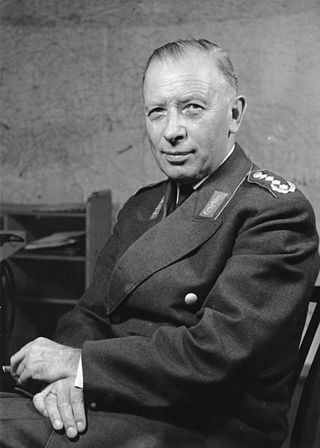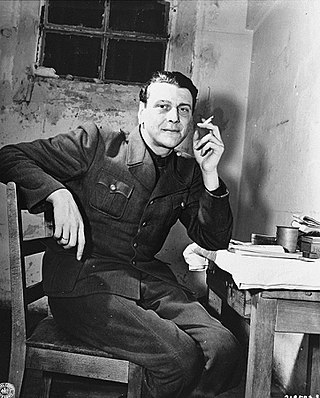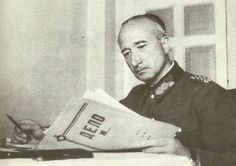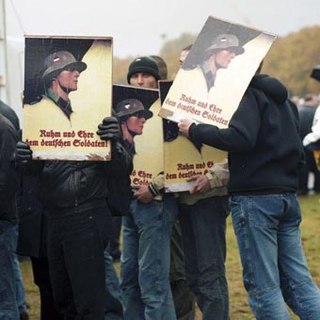
Otto Johann Anton Skorzeny was an Austrian-born German SS-Obersturmbannführer in the Waffen-SS during World War II. During the war, he was involved in a number of operations, including the removal from power of Hungarian Regent Miklós Horthy and the Gran Sasso raid which rescued Benito Mussolini from captivity. Skorzeny led Operation Greif in which German soldiers infiltrated Allied lines wearing their enemies' uniforms. As a result, he was charged in 1947 at the Dachau Military Tribunal with breaching the 1907 Hague Convention, but was acquitted.

The National People's Army were the armed forces of the German Democratic Republic (GDR) from 1956 to 1990.

The German Army is the land component of the armed forces of Germany. The present-day German Army was founded in 1955 as part of the newly formed West German Bundeswehr together with the Marine and the Luftwaffe. As of 2024, the German Army had a strength of 63,047 soldiers.

Reinhard Gehlen was a German military and intelligence officer who served the Weimar Republic, Nazi Germany, and West Germany, and also worked for the United States during the early years of the Cold War. He was in charge of German military intelligence on the Eastern Front of World War II and was later the first director of West Germany's intelligence agency, the Federal Intelligence Service (BND). Gehlen is also considered to be one of the founders of the West German armed forces, the Bundeswehr.

The Federal Intelligence Service is the foreign intelligence agency of Germany, directly subordinate to the Chancellor's Office. The BND headquarters is located in central Berlin. The BND has 300 locations in Germany and foreign countries. In 2016, it employed around 6,500 people; 10% of them are military personnel who are formally employed by the Office for Military Sciences. The BND is the largest agency of the German Intelligence Community.

Hans Speidel was a German military officer who successively served in the armies of the German Empire, Nazi Germany and West Germany. The first general officer of the Bundeswehr, he was a key player in West German rearmament during the Cold War as well as West Germany's integration into NATO and international negotiations on European and Western defence cooperation in the 1950s. He served as Commander of the Allied Land Forces Central Europe (COMLANDCENT) from 1957 to 1963 and then as President of the German Institute for International and Security Affairs from 1964.

Adolf Bruno Heinrich Ernst Heusinger was a German military officer whose career spanned the German Empire, the Weimar Republic, Nazi Germany, West Germany and NATO. He joined the German Army as a volunteer in 1915 and later became a professional soldier. He served as the Operations Chief within the general staff of the High Command of the German Army in the Wehrmacht from 1938 to 1944. He was then appointed acting Chief of the General Staff for two weeks in 1944 following Kurt Zeitzler's resignation. That year, Heusinger was accused of involvement in the 20 July plot to assassinate Adolf Hitler, but was cleared by the People's Court. Heusinger was later appointed head of the military cartography office when the war ended. He later became a general for West Germany and served as head of the West German military from 1957 to 1961 as well as Chairman of the NATO Military Committee from 1961 to 1964.
Gerhard Wessel was President of the Federal Intelligence Bureau from May 1968 to December 1978. He previously served in the Reichswehr (1932–35) and Army, including the Foreign Armies East of Reinhard Gehlen during World War II. After the war, he was part of the Gehlen Organisation, and then the Bundeswehr (1956–1952).
Heinz Paul Johann Felfe was a German spy.

Die Spinne was a post-World War II organisation that helped certain Nazi war criminals escape prosecution. Its existence is still debated to this day. It is believed by some historians to be a different name for, or a branch of ODESSA, an organisation established during the collapse of Nazi Germany, similar to Kameradenwerk and der Bruderschaft, and devoted to helping German war criminals flee Europe. It was led in part by Otto Skorzeny, as well as by German intelligence officer Reinhard Gehlen. Die Spinne helped as many as 600 former SS men escape from Germany to Francoist Spain, Juan Peron's Argentina, Paraguay, Chile, Bolivia, the Middle East and elsewhere.

Arno Ernst Max von Lenski was a German military officer and general who served in the Imperial German army, the Wehrmacht of Nazi Germany, and after the war in the National People's Army of the German Democratic Republic, where he was also a politician.
The Gehlen Organization or Gehlen Org was an intelligence agency established in June 1946 by U.S. occupation authorities in the United States zone of post-war occupied Germany, and consisted of former members of the 12th Department of the German Army General Staff. It was headed by Reinhard Gehlen who had previously been a Wehrmacht Major General and head of the Nazi German military intelligence in the Eastern Front during World War II.

Rudolf von Bünau was a German general in the Wehrmacht during World War II who commanded several corps. He was a recipient of the Knight's Cross of the Iron Cross with Oak Leaves of Nazi Germany. His son, also named Rudolf von Bünau, was awarded the Knight's Cross of the Iron Cross on 8 August 1943; he was killed in action just one week later on 15 August 1943 south of Roslavl. His other son, Günther von Bünau was also killed in action in 1943. Rudolf von Bünau would survive the war. He was interned by the Americans until April 1947. Rudolf was killed in a car crash in 1962.
Operation Scherhorn or Operation Berezino or Operation Beresino was a secret deception operation performed by the NKVD against the Nazi secret services from August 1944 – May 1945. It was proposed by Joseph Stalin, drafted by Mikhail Maklyarsky and executed by Pavel Sudoplatov and his NKVD subordinates, assisted by German antifascists and communists.
Agency 114 was a Cold War-era clandestine front of the postwar West German intelligence agency, the Bundesnachrichtendienst (BND), which served as the main entrance point, into the field of domestic counterintelligence, for former Nazis, including war criminals active in the Holocaust who have never been brought to justice.

Albert Schnez was an officer in three successive German armies: the Reichswehr, the Wehrmacht, and finally the Bundeswehr, the armed forces of the modern Federal Republic of Germany. He was involved in the debate on the internal leadership of the newly formed Bundeswehr and was close to the German defense minister, Franz Josef Strauss. Schnez served from 1968 to 1971 with the rank of lieutenant-general (Generalleutnant) as the Inspector of the Army.

The myth of the clean Wehrmacht is the negationist notion that the regular German armed forces were not involved in the Holocaust or other war crimes during World War II. The myth, heavily promoted by German authors and military personnel after World War II, completely denies the culpability of the German military command in the planning and perpetration of war crimes. Even where the perpetration of war crimes and the waging of an extermination campaign, particularly in the Soviet Union – the populace of which was viewed by the Nazis as "sub-humans" ruled by "Jewish Bolshevik" conspirators – has been acknowledged, they are ascribed to the "Party soldiers corps", the Schutzstaffel (SS), but not the regular German military.
Waffen-SS veterans in post-war Germany played a large role, through publications and political pressure, in the efforts to rehabilitate the reputation of the Waffen-SS, which had committed numerous war crimes during World War II. High ranking German politicians courted former Waffen-SS members and their veteran organisation, HIAG. A small number of veterans, somewhat controversially, served in the new German armed forces, the Bundeswehr.
The Study and Training Group for Military Reconnaissance was a highly classified clandestine unit of the foreign intelligence agency of Germany, Bundesnachrichtendienst (BND) from 1964 to 1979.












